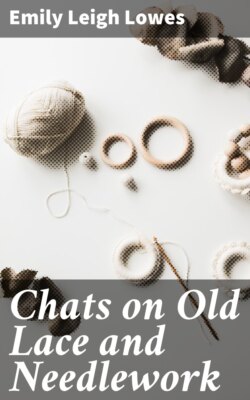Читать книгу Chats on Old Lace and Needlework - Emily Leigh Lowes - Страница 9
На сайте Литреса книга снята с продажи.
The Venetian Laces
ОглавлениеTable of Contents
Venetian lace—"Rose Point"—"Point de Neige"—"Gros Point"—"Punto Tagliato a Foliami"—The South Kensington Collection.
Needlepoint lace is made with needle and thread and principally in buttonhole stitches. A traced parchment pattern is procured, the outline made with a solitary thread stitched down to the parchment at frequent intervals. The thread is then worked over with fine buttonhole stitches; the modes or fillings have a fine network of threads stretched across, afterwards being buttonholed into a variety of designs. The edges are then again worked upon with loops or picots, and in "Rose Point" tiny stars or roses are worked on suitable parts of the design, sometimes the "roses" or "stars" being three in numbers, one poised upon the other. This is known as "Point de Neige" the whole surface of the lace being literally sprinkled with tiny stars somewhat representing a fine snowfall. The design is then connected with fine "brides," these in their turn being dotted and purled with stars and loops. Most of this exquisite lace requires a powerful magnifying-glass to discern the intricacy of the work.
The finest lace of this variety was produced in the sixteenth century, the designs being bold, handsome, and purely Renaissance in type. That of the Louis Quatorze period shows the personal influence of his reign, frequently having tiny figures worked in the design. A collar in my possession has the Indian worshipping the sun (the King's glory was said to rival that of the sun) repeated in each scallop. This was a favourite design in the magnificent "Point de France" which was made during the long reign of Louis, under the management of Colbert.
It is absolutely certain that the laces known as Venetian Point originated in Italy. Pattern books still exist showing how the early Reticella developed into this magnificent lace. In the National Library at the South Kensington Museum, may be seen the very patterns designed by Vinciolo, Vicellio, and Isabella Parasole. These publications actually came from Venice, and being reproduced in France, Germany, Belgium, and England, quickly aroused immense enthusiasm, and lace-making spread far and wide, at first all other laces being mere imitations of the Venetian.
CORALLINE POINT (VENETIAN).
POINT PLAT DE VENISE (FLAT VENETIAN). (Author's Collection.)
MARIE DE MEDICIS WEARING THE MEDICIS COLLAR TO DISPLAY VENETIAN LACES.
The chief varieties of the Venetian laces are known as Rose Point, Point de Neige, Gros Point de Venise (often erroneously attributed to Spain and called Spanish Point), and Point Plat de Venise. A much rarer variety is "Venetian point à réseau," which is the flat point worked round with a Needlepoint ground or mesh, the network following no proper order but being simply worked round the pattern and following its curves.
The chief characteristics of Venetian lace are the buttonhole Cordonnet, fine or thick according to the style of lace; the wonderful diversities of the fillings worked in buttonhole stitches; the elaborate decoration of the Cordonnet; and the starry effects of the brides or ties. In the flat Venetian Point there is no Cordonnet.
These Italian laces were admired and purchased by all the European countries, and the cities of Venice and Florence made enormous fortunes. The fashions of the day led to their extensive use, Marie de Medicis introducing the Medici collar trimmed with Venetian points specially to display them. At a little later period the collar became more falling and the heavier "Gros point" was used. Men and women alike wore lace-trimmed garments to an excessive degree, the collar and cuff trimmings being composed of wide Venetian lace and the silken scarf worn across the body being edged with narrower and finer lace.
The principal designs for the Venetian lace of all periods were scrolls of flowers conventionalised in the Renaissance taste of the time. The generic name for all laces of the finest period is "Punto tagliato a foliami." The laces of this time are now almost priceless. They are genuine works of art, worked slowly and patiently under the clear light of the Italian skies by women who were naturally artistic and beauty loving, and who, while working the shining needle and fairy thread in and out of the intricacies of the design sang the pretty "Lace Songs" which may be heard at the Burano Lace School even now, although 200 or 300 years old. Many specimens of this exquisite lace are to be found in the South Kensington Museum, where the flounce given by Mrs. Bolckow at once explains the whole scheme of Venetian lace-making.
Such lace is not to be purchased now except at great price. The piece illustrated, see page 55, was only 1–⅛ yards in length, and was sold for £145 by one of our leading lacemen. Barely 5 yards of Venetian lace, only 2 inches wide and in rags, was sold at Debenham & Storr's in August, 1907, for £60; and even the smallest collar or a pair of cuffs runs well into £10.
Even in the days of its manufacture this lace commanded high prices. In the inventory of Queen Elizabeth's gowns we find such entries as—
"To 1 yard Double Italian Cut-worke,¼ yd. wide. 55/4.
" 3 yds. broad needlework lace of Italy, with purls. 50/- per yd."
James II. paid £29 for a cravat.
VERY FINE EXAMPLE OF "GROS POINT DE VENISE."
